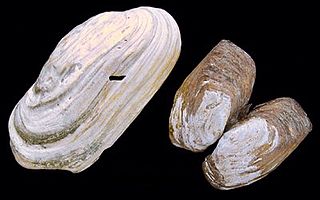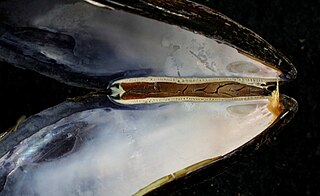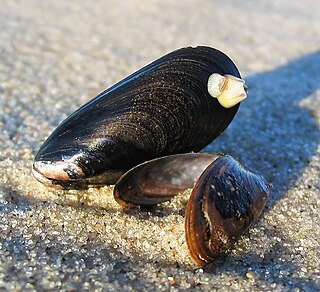
Bivalvia, in previous centuries referred to as the Lamellibranchiata and Pelecypoda, is a class of marine and freshwater molluscs that have laterally compressed bodies enclosed by a shell consisting of two hinged parts. Bivalves as a group have no head and they lack some usual molluscan organs like the radula and the odontophore. They include the clams, oysters, cockles, mussels, scallops, and numerous other families that live in saltwater, as well as a number of families that live in freshwater. The majority are filter feeders. The gills have evolved into ctenidia, specialised organs for feeding and breathing. Most bivalves bury themselves in sediment where they are relatively safe from predation. Others lie on the sea floor or attach themselves to rocks or other hard surfaces. Some bivalves, such as the scallops and file shells, can swim. The shipworms bore into wood, clay, or stone and live inside these substances.

The order Ostreida includes the true oysters. One superfamily and two families are recognised within it. The two families are Ostreidae, the true oysters, and Gryphaeidae, the foam oysters.

The Arcida is an extant order of bivalve molluscs. This order dates back to the lower Ordovician period. They are distinguished from related groups, such as the mussels, by having a straight hinge to the shells, and the adductor muscles being of equal size. The duplivincular ligament, taxodont dentition, and a shell microstructure consisting of the outer crossed lamellar and inner complex crossed lamellar layers are defining characters of this order.

The Pterioida are an order of large and medium-sized marine bivalve mollusks. It includes five families, among them the Pteriidae.

The Pteriomorphia comprise a subclass of saltwater clams, marine bivalve mollusks. It contains several major orders, including the Arcoida, Ostreoida, Pectinoida, Limoida, Mytiloida, and Pterioida. It also contains some extinct and probably basal families, such as the Evyanidae, Colpomyidae, Bakevelliidae, Cassianellidae, and Lithiotidae.

Palaeoheterodonta is a subclass of bivalve molluscs. It contains the extant orders Unionida and Trigoniida. They are distinguished by having the two halves of the shell be of equal size and shape, but by having the hinge teeth be in a single row, rather than separated into two groups, as they are in the clams and cockles.

Heterodonta is a taxonomic subclass of saltwater clams, marine bivalve molluscs. This subclass includes the edible clams, the cockles and the Venus clams.

Unionida is a monophyletic order of freshwater mussels, aquatic bivalve molluscs. The order includes most of the larger freshwater mussels, including the freshwater pearl mussels. The most common families are the Unionidae and the Margaritiferidae. All have in common a larval stage that is temporarily parasitic on fish, nacreous shells, high in organic matter, that may crack upon drying out, and siphons too short to permit the animal to live deeply buried in sediment.
Anomalodesmata is an order of saltwater clams, marine bivalve molluscs. This grouping was formerly recognised as a taxonomic subclass. It is called a superorder in the current World Register of Marine Species, despite having no orders, to parallel it with sister taxon Imparidentia, which does have orders.

Hiatellidae is a taxonomic family of saltwater clams, marine bivalve molluscs. This family is placed in the order Adapedonta.

Mollusca is the second largest phylum of invertebrate animals. The members are known as molluscs or mollusks. Around 85,000 extant species of molluscs are recognized. The number of fossil species is estimated between 60,000 and 100,000 additional species.

The Pectinoidea are a superfamily of marine bivalve molluscs, including the scallops and spiny oysters.

Protobranchia is a subclass of bivalve molluscs. It contains the extant orders Nuculanida, Nuculida, and Solemyida.
Pectinoida is a taxonomic suborder of large and medium-sized saltwater clams, marine bivalve mollusks, commonly known as scallops and their allies. It is believed that they began evolutionarily in the late Middle Ordovician era; many species, of course, are still extant.

A hinge ligament is a crucial part of the anatomical structure of a bivalve shell, i.e. the shell of a bivalve mollusk. The shell of a bivalve has two valves and these are joined together by the ligament at the dorsal edge of the shell. The ligament is made of a strong, flexible and elastic, fibrous, proteinaceous material which is usually pale brown, dark brown or black in color.

The adductor muscles are the main muscular system in bivalve mollusks, i.e. in clams, scallops, mussels, oysters, etc. In many parts of the world, when people eat scallops, the adductor muscles are the only part of the soft parts of the animal which are eaten. Adductor muscles leave noticeable scars or marks on the interior of the shell's valves. Those marks are often used by scientists who are in the process of identifying empty shells to determine their correct taxonomic placement.
Lucinida is a taxonomic order of saltwater clams, marine bivalve molluscs.

Cyrenidae is a family of clams in the order Venerida.

Septifer bilocularis is a marine bivalve species in the family Mytilidae, the mussels.

















